It’s a question we get a lot: How accurate is the PI Behavioral Assessment™? And for good reason. A lot of behavioral reports out there use pseudoscience to determine workplace drives and needs—not true psychometrics. At The Predictive Index®, we strive for the latter.
To ensure scientific accuracy, we routinely reexamine our assessments, and welcome feedback from those who use them. The PI Behavioral Assessment is no exception. To verify its accuracy, our science team did what they do best: conduct research.
How accurate are the PI Behavioral Assessment results?
Numerous studies have shown the results of the PI Behavioral Assessment to be valid and reliable (e.g., Fossey, 2017; Foster et al., 2016). We’ve also seen countless anecdotal testimonials from business leaders who have used the BA. These G2 Crowd reviews speak for themselves:
“The depth of insights collected from a simple assessment is phenomenal.” – Sam S., Executive Director
“The most accurate behavioral assessment I have used” – Wendy W., Human Resources Director
And check out what some of our certified PI Partners had to say about our behavioral assessment:
“One of my clients is the executive team of a large bank. I did behavioral readbacks for 23 of 26 members of the team. Every single one said the assessment was ‘spot-on’ or ‘scary’ when describing their behavioral drives and needs in the workplace—it was that accurate.” – Kevin Waters, Clear Leader Group
“PI allows us to really dive deep with the leaders. It’s the most powerful thing we offer, and it takes the drama out of the situation. We bring up their data first and allow them to talk about their team. We then help them understand why they may be struggling with a certain person and help them figure out an effective workaround.” – Bob Borscherdt, IN2GREAT
When an employee takes the PI Behavioral Assessment, they receive their behavioral pattern, their Reference Profile, and a written “person report.”
There’s plenty of data showing how accurate the behavioral pattern and Reference Profile are. However, there’s been little quantitative research to measure how well the more interpretive report describes one’s motivational drives.
Until now.
What is the PI Behavioral Assessment report?
The PI Behavioral Assessment report is a 2- to 3-page report generated based on a respondent’s behavioral pattern. By default, the report contains the following:
- Graphs of the individual’s Self, Self-Concept, and Synthesis
- Summary of the person’s behavioral drives
- Description of the individual’s strongest behaviors
- Actionable management strategies
Software users can also select from three additional sections—“management style,” “influencing style,” and “selling style”—to include in the report.
Below is a sample of the “strongest behaviors” section of one report:
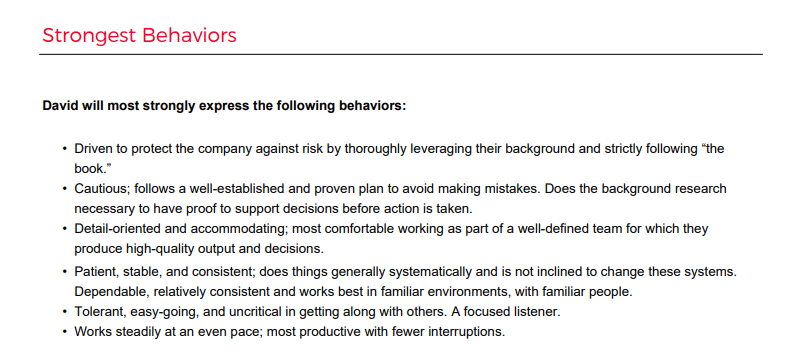
It should be noted that a BA report is generated based on a respondent’s behavioral pattern—not their Reference Profile. Since the 17 Reference Profiles help categorize a variety of behavioral patterns, it’s entirely possible for two respondents with the same Reference Profile to receive different reports.
(Watch this video to learn more about the differences between Reference Profiles and behavioral patterns.)
Studying the accuracy of the PI Behavioral Assessment reports
Between May 2018 and August 2019, the science team conducted a study, titled “Report Accuracy,” to assess how accurate respondents found their BA reports to be.
For the duration of the study, the team included a survey link at the bottom of any PI email containing a person’s behavioral report. The link invited respondents to share their feedback. An example is shown below:
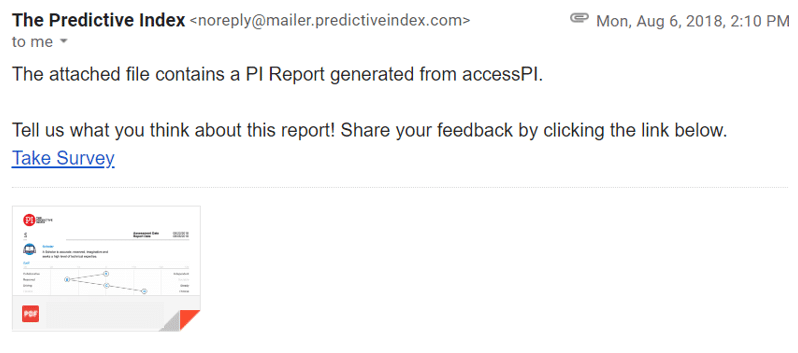
Respondents who clicked the link were directed to a survey hosted by GetFeedback, Inc. The survey was short, presenting respondents with three or four questions, depending on their answers.
The full survey flow is shown below:
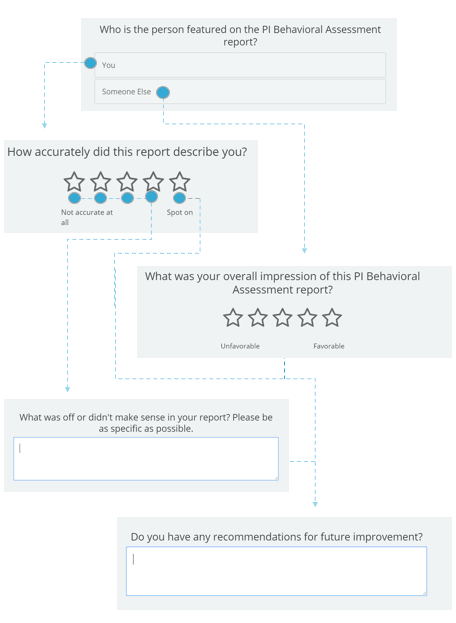
How many people responded?
The report survey averaged 59 responses per week—starting at more than 100 responses in its first week, then gradually declining over time. The lowest point was in December 2018—likely because fewer assessments were sent that month than in the preceding months.
The below chart shows the total number of responses submitted per month. Data are shown for all full months that the survey link was available (June 2018 through August 2019):
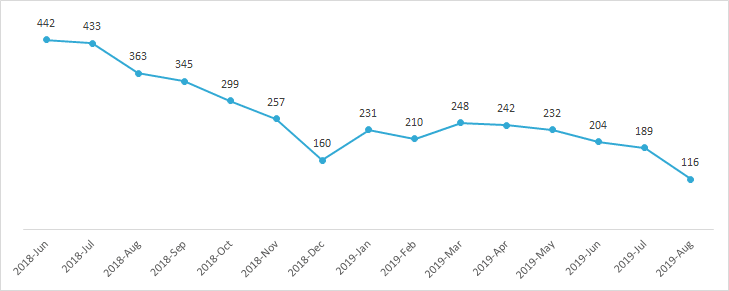
What were the results?
4,032 people completed the survey between May 25, 2018 and September 9, 2019. Of those, 3,535 (88%) of respondents completed the survey for their own BA report, and 497 (12%) reported they were completing the survey for a BA report that was not their own.
When asked how accurately the PI Behavioral Assessment report described them, the 3,535 respondents provided an average rating of 4.4. 86% of respondents provided a rating of 4 or 5, both of which are considered to indicate high report accuracy.
The below chart shows the distribution of the ratings given by the 3,535 respondents:
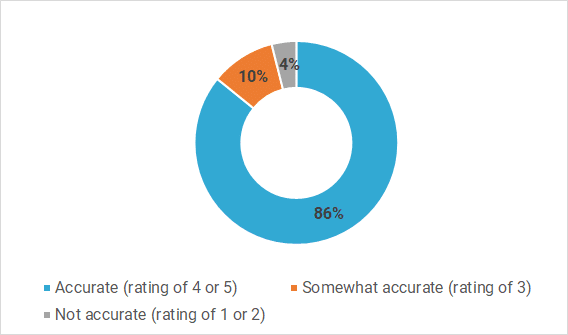
The results were clear: The vast majority of those surveyed felt the BA report accurately described their behavioral drives.
Perhaps more interesting, though, was how these results translated to the 17 Reference Profiles.
Reference Profile-specific results
Through GetFeedback, we were able to record respondent email addresses. This made it possible to match respondents’ feedback and ratings to their own behavioral patterns—and Reference Profiles. Following this matching process, all data were anonymized
As shown in the below graph, the Reference Profile reports with the most occurrences were Operator and Collaborator, both of which were associated with 9% of total survey responses. In contrast, Analyzer and Adapter were both associated with only 3% of responses.
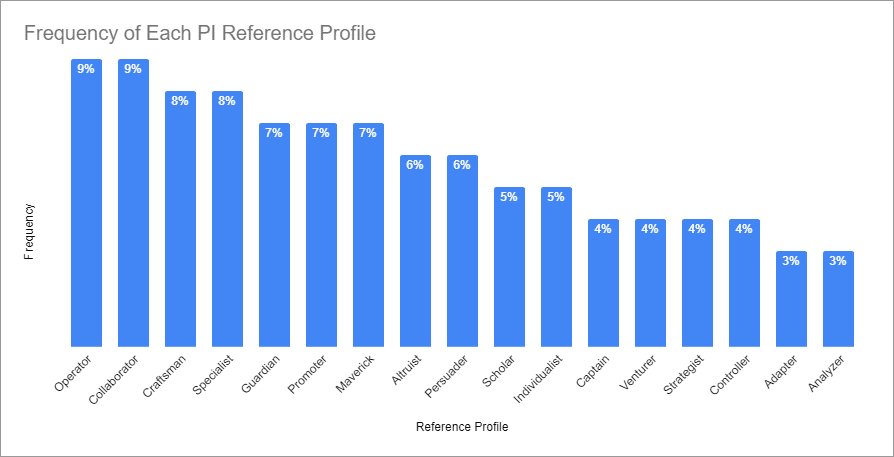
In terms of rating, the Reference Profile reports considered most accurate by respondents were for Captain, followed by Persuader. By contrast, the least accurate were for Individualist, then Adapter.
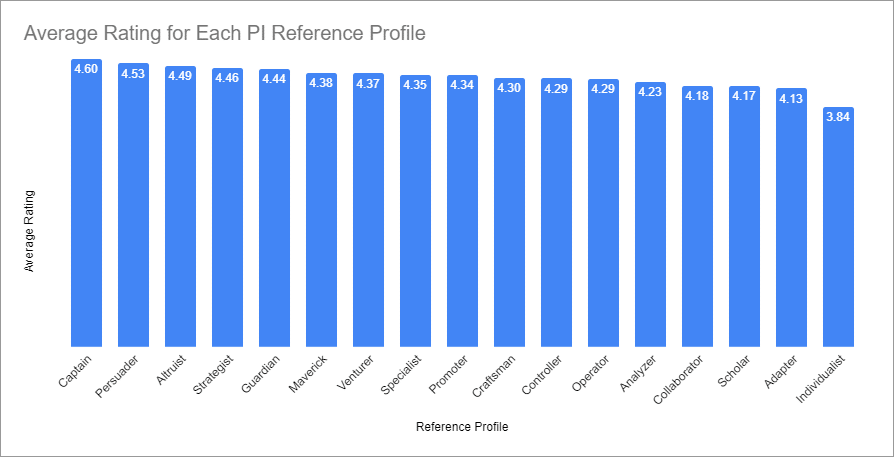
Examining the data, all of the Reference Profile reports were considered to be highly accurate. Even Individualist reports, which scored the lowest of the Reference Profiles, received relatively favorable ratings.
Conclusion—and takeaways
Let’s return to the question at hand: Is the PI Behavioral Assessment accurate? Based on past validity and reliability studies, coupled with these new findings, signs point largely to yes.
Despite the highly satisfactory outcome of these studies, it may be worth revisiting the reports of certain Reference Profiles—like Individualist—in the future. These may benefit from further analysis of the open-ended responses of our recent findings.
As with everything we do at PI, we’ll continue to refine and reassess the PI Behavioral Assessment to ensure its continued accuracy, reliability, and fairness.
Join 10,000 companies solving the most complex people problems with PI.
Hire the right people, inspire their best work, design dream teams, and sustain engagement for the long haul.








